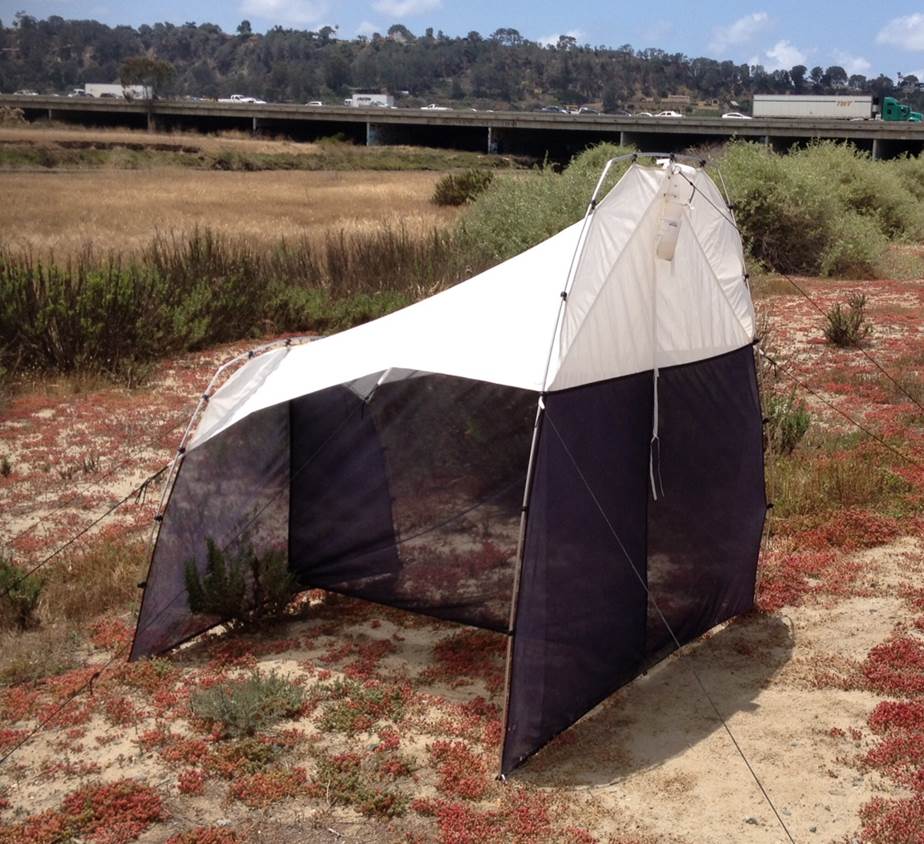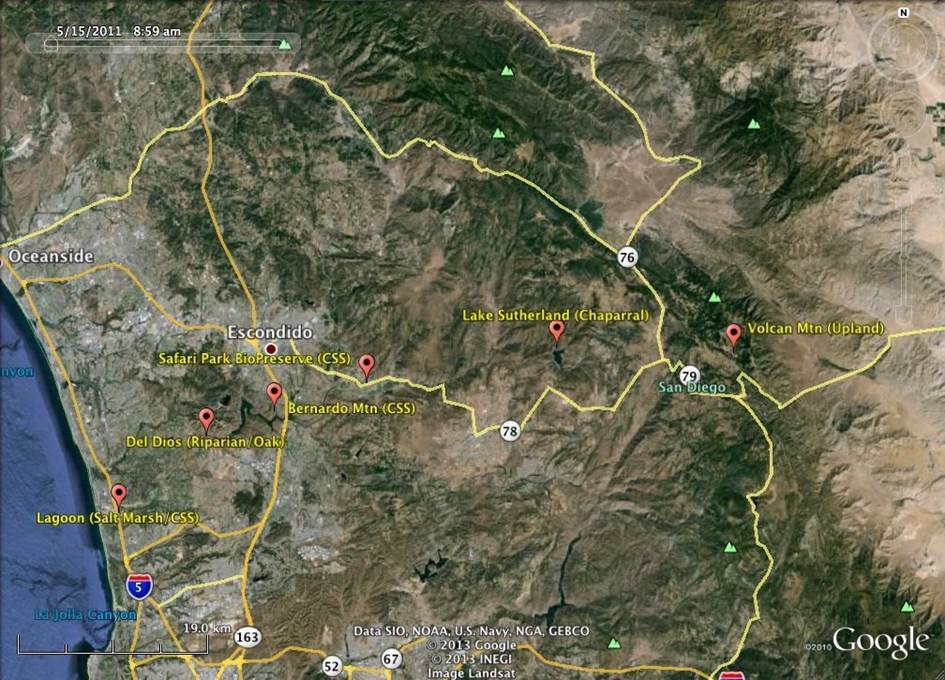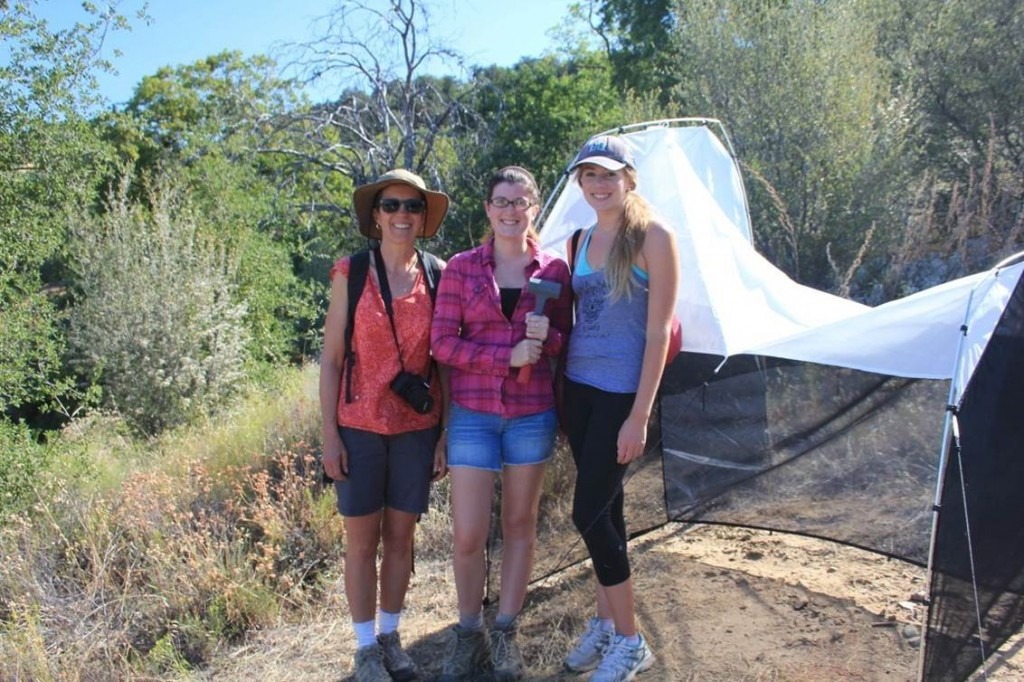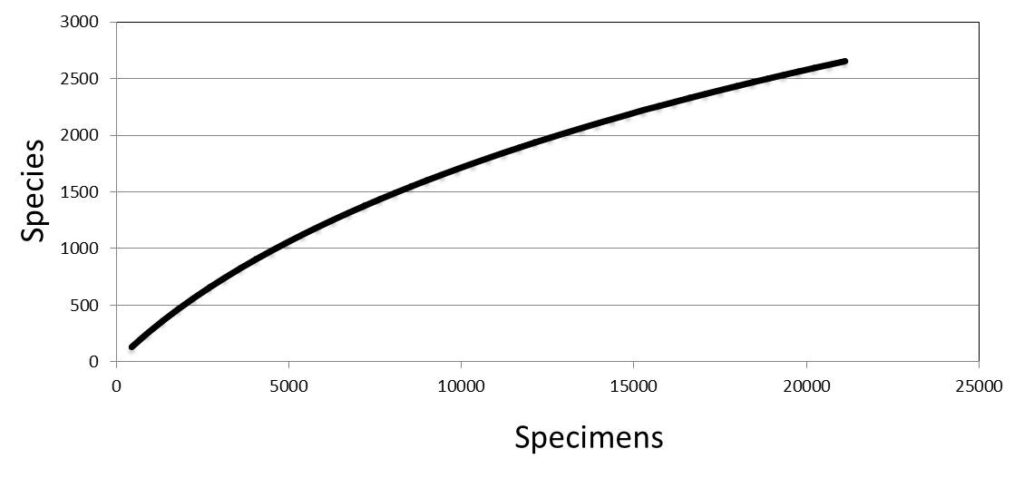
For eight weeks a year, as you drive north on I-5 you can see what looks like a backpacker’s tent perched near the water of the San Dieguito Lagoon just east of the freeway. Who would camp there? Nobody.
What looks like a tent is really a malaise trap, an apparatus for sampling flying insects. The San Dieguito River Park and Conservancy, in conjunction with scientists at UCSD, the San Diego Zoo Institute for Conservation Research, and the Biodiversity Institute of Ontario are conducting an insect biodiversity survey of the SDRP as part of a worldwide effort to document the earth’s biodiversity using a genetic technique known as DNA barcoding.
The SDRP is an excellent place for such a study as it encompasses a protected watershed in a region (Southern California) recognized as a global biodiversity hotspot.
Six malaise traps are deployed in a transect stretching the length of the San Dieguito River watershed from Volcan Mountain west to the San Dieguito Lagoon.

Each trap is open for two weeks each calendar quarter (August, November, February and May). Malaise traps look like tents for people that hate each other. There is no outer wall but instead a single mesh wall runs lengthwise down the center of the tent. Flying insects that hit that wall often walk or fly upwards to get over the barrier. If they reach the peak of the tent, they fall into a jar and are preserved.
Collected specimens are sent to the Biodiversity Institute of Ontario where each one is sorted to order (for instance, flies, wasps, moths, etc.) and DNA barcoded. DNA barcoding involves sequencing just enough DNA of a particular gene to uniquely identify species. For insects, spiders, and most animal groups, that gene is cytochrome oxidase 1 (CO1). For this gene, individuals within a species seldom differ by as much as 2% of their nucleotides, while differences between species are usually far greater. A computer algorithm clusters groups of similar sequences and each cluster usually represents one species. At least one representative of each cluster is also photographed. Even in the absence of specialists with expertise in each insect group, one can determine the number and types of species present. The goal of the Barcode of Life Database is to genetically document as much of Earth’s biodiversity as possible.
In the first year, 25,108 insect specimens were collected, approximately 500 per trap per week. Sounds like a lot of bugs but fear not, insect populations are very large and we only scratch the surface. 21,118 specimens were successfully sequenced and DNA barcoding differentiated 2656 species. The trap on Volcan Mountain captured the highest number of different species while the one next to the lagoon captured the fewest. There was marked spatial and temporal structure to the insect communities sampled. More species are shared in common by adjacent than more distant traps, and more species at the same trap are shared among samples separated by three than six months. Very few datasets are available to ecologists concerning the spatial and temporal variation in overall insect communities so this alone is a valuable contribution.

Of the 2,656 species sequenced, 1,371 (52%) are known only from this study in the Barcode of Life Database, representing the first genetic information for these taxa.
Unidentified hemipteran (true bug) family Pyrrhocoridae collected from the SDRP survey. Possibly the recent invasive Scantius aegyptius? The SDRP study provided the first genetic sequence information on this bug. Its genetic cluster or BIN (Barcode Index Number) is BOLD:ACL0625.
How many of these species are new to science?
We don’t yet know, though it is likely that some are. It will take a bevy of trained taxonomists to determine the precise species represented by each cluster of DNA sequences. DNA barcoding provides a rapid assessment of diversity, but trained taxonomists are needed to determine whether a particular group of specimens represent a previously undescribed species. Fortunately, each specimen is preserved for future study.
How many insect species are there in SDRP?
We need to do more sampling to determine this. We do know the total very large. Of the 2,656 species found in the first year, 1,157 (43%) were represented by just a single specimen! To estimate the total number of species, we need to estimate how many species there are that were never caught, the “known unknowns” to borrow from a recent politician. Estimating this is a tricky mathematical problem that even the famous code cracker Alan Turing attempted to solve. All we can estimate at present is that the total number of insect species within SDRP is over 4000, but probably much greater.

Because there is no sign of an asymptote, it is not yet possible to accurately estimate the total number of insect species.
How will the information gathered from SDRP be used?
First, this survey provides a useful baseline of insect diversity present within the San Dieguito watershed at this point in time. It is very difficult to protect biodiversity when you don’t know what you have, and the biodiversity of insects, particularly small ones, is very poorly known. While Southern California is a biodiversity hotspot for plants and vertebrates, little is known about levels of insect diversity, though it too can be expected to be high. Second, similar malaise trap insect surveys are taking place worldwide providing useful comparisons of biodiversity in different regions. Finally, the genetic information collected often points specialists to species or groups worth further investigation. For instance, when specimens thought to represent one species break up into two genetic clusters, it is possible that these clusters represent “cryptic species”, cases where two species are so similar they are classified as one, even though they do not interbreed. Often careful review of morphology can, in hindsight, resolve these into separate groups, and a new species can be described. Perhaps a species yet to be described will bear the name dieguito one day in honor of SDRP.
Featured Image: Dr. Heather Henter and two former UCSD undergraduates erect malaise trap on Volcan Mountain near Julian.
For further information: Questions can be directed to professor Joshua Kohn (jkohn@ucsd.edu).


 Arroyo Toad
Arroyo Toad